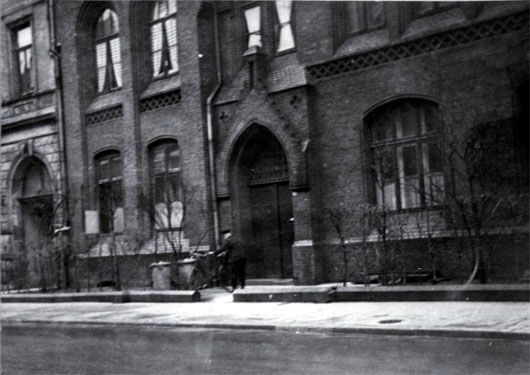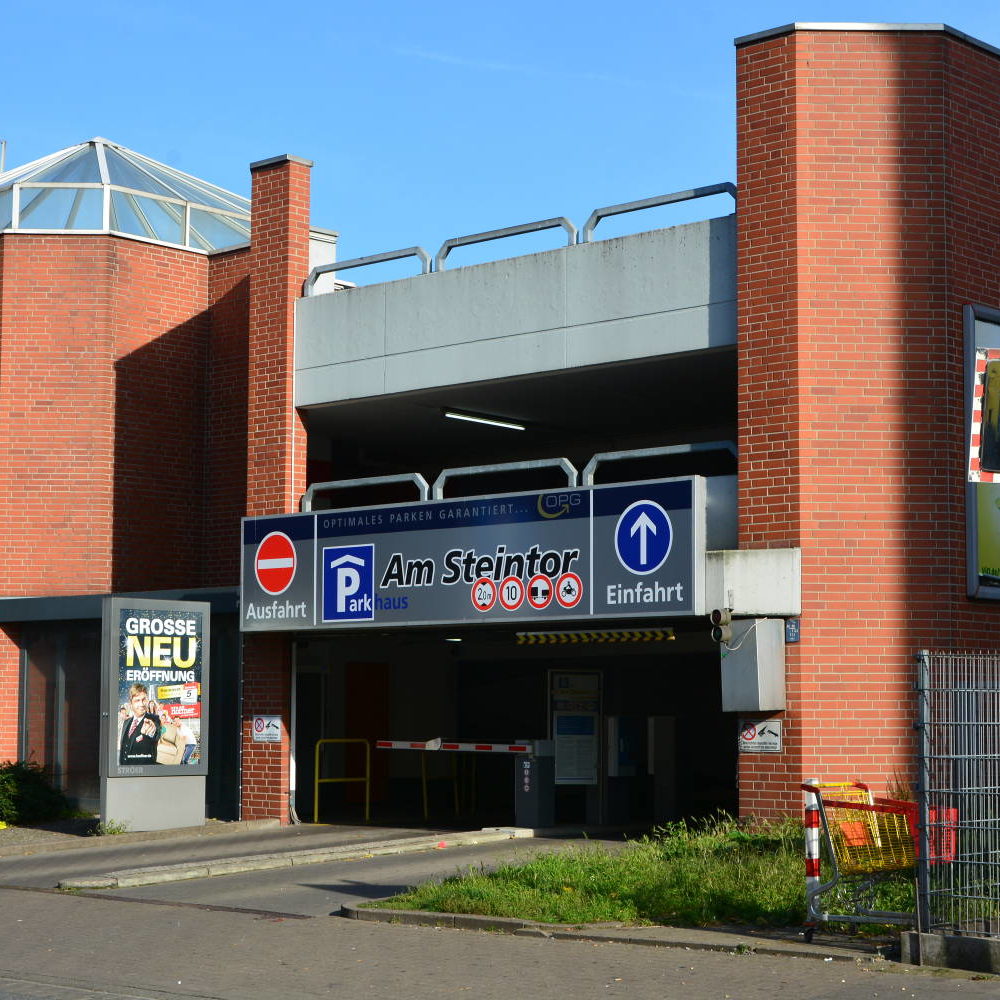Once a centre of Jewish life: on the site where a bland multi-storey car park now stands, there once stood the community house, a centre of Jewish life in Hanover. The commission for its design had been awarded in 1875 to the architect Edwin Oppler who, not long before, had built the New Synagogue.

Life in the community
After Jews are granted equal rights under the law, the Jewish Community in Hanover expands rapidly. Following the rise in their registered members, a new community house is built. The community’s office staff as well as the cemetery administration, welfare office and the community library all move into the finished red-brick, three-storey building. In addition, there are classrooms for teaching religious education. On the top floor there is an apartment, which serves as the living quarters for the family of the community secretary.
In 1925, a second community house is acquired in Ohestrasse near Waterlooplatz. It has a neighbouring building that houses a Jewish kindergarten and an after-school care centre for schoolchildren. The front of the building accommodates welfare facilities, such as a soup kitchen, a clothing bank and a nurse’s station.
A school is founded
In May 1935, lessons begin at a Jewish school with four teachers and 84 schoolchildren in the building at Lützowstrasse 3. The aim is for children to be able to learn in an environment that is not burdened by the increasing anti-Semitism. A few years later, it is the only school in Hanover, apart from the school at the Israelite Horticultural School Ahlem, where Jewish children are still allowed to be taught: after the “Night of Pogroms” on the 9th to the 10th of November 1938, throughout Germany Jews were forbidden to attend state schools because – according to the Reichsminister for Education Bernard Rust – it is “beyond all bearing for German schoolchildren to sit in a classroom with Jews”. Jewish children are now barred from secondary schools. Attendance at vocational schools is only permitted if – as in Ahlem – it serves the purpose of emigration.
„Jewish House“
Numerous community members move into the Lützowstraße building in 1939 and 1940 because they have been evicted by their “Aryan” landlords. Therefore, in April 1940, the elementary school is moved to the Ohestraße community center and classes continue there until the beginning of September 1941. For the time after that, the city administration has another use for the two community centers and 13 other Jewish properties. The community center in Lützowstrasse becomes one of Hanover’s 15 “Jewish houses”. On September 3 and 4, 1941, 125 people move into the 11 rooms of the house: Families, married couples, single people. Almost all of them leave Hanover with the first big deportation on December 15, 1941 to the Riga ghetto; the few who stay behind are grouped together in other “Judenhäuser”.
Herskovits family
Samuel Herskovits (1883-1944) has been secretary and since 1935 also head cantor of the Jewish community of Hannover. Like his first wife Helene née Kiss (1894-1939) he was born in Transylvania in today’s Romania. The family inhabited an apartment on the third floor of the Gemeindehaus Lützowstraße with their children: the first-born Margarete (1922-2002) and the twins Ruth (1928-2016) and Eva (1928-1972). The disabled daughter Klara (1924-1940) lives in a children’s home of the municipality on the island of Norderney. Ruth and Eva soon have a short way to school: after starting school in a municipal school, they transfer in 1935 for the second school year to the Jewish elementary school that has just been established in their home. In view of the dramatically worsening situation of German Jews, both are taken to the supposedly safe Netherlands on a Kindertransport at the beginning of 1939; their older sister Margarete emigrates to Great Britain.
Failed escape
Helene Herskovits dies of an illness in 1939. Samuel Herskovits marries the widowed Mania Münzer (1898-1945), who brings her daughter Lotte (1925-1944) into the marriage. Because of a planned emigration, the twins are brought back to Hanover – but the approval by the Hanover Gestapo does not reach the family until four days after the final ban on emigration of October 23, 1941. Even before that, they have to share their apartment in the community center – now “Judenhaus” – with numerous people. After forced stays in the “Jews’ Houses” Ohestraße and Jewish Horticultural School Ahlem, the family is deported from the Fischerhof train station to the Theresienstadt ghetto on June 30, 1943. At this time Lotte Münzer is pregnant from a love affair with an Ahlem gardener apprentice, and her son Denny is born in the ghetto in October 1943. Mother and child are murdered in the Auschwitz concentration camp, as is Samuel Herskovits, Mania in the Stutthof concentration camp. Klara Herskovits died already in 1941 in the Nazi “euthanasia”. The twins Ruth and Eva survive the concentration camps Theresienstadt and Auschwitz as well as subcamps of the concentration camps Groß-Rosen and Neuengamme. After a long stay in Swedish convalescent homes, they emigrate to the USA and Great Britain.
After the last Jewish occupants move out in February 1942, the community house stands empty. It is not known whether the building has new occupants after it is vacated. It is completely destroyed during the air raid from 8th to 9th October 1943.
Additional online information
Wikipedia entry Edwin Oppler
Wikipedia entry History of the Jews in Hanover
Youth! 1918-1945 Exclusions [in German]
Wikipedia entry Education under National Socialism [in German]
Further reading: Click here
Texts and images: Michael Pechel

![Hanover: Jewish Community House in Lützowstrasse 3, street-facing front. Architectural drawing from: Peter Eilitz: Leben und Werk des königl. hannoverschen Baurats Edwin Oppler [Life and Work of the Royal Hanoverian Architect Edwin Oppler]. In: Hannoversche Geschichtsblätter. New edition, Volume 25, 1971](https://zukunft-heisst-erinnern.de/wp-content/uploads/2020/03/gemeindehaus_vorderfront-527x527.jpg)
